Dell UltraSharp U2711: Quality has a Price
by Jarred Walton on January 22, 2010 2:00 AM EST- Posted in
- Displays
Dell U2711 Color Quality
We'll start with a look at the color quality of the U2711, broken down into two areas: Color gamut and color accuracy (i.e. Delta E). We'll start by explaining the former. Color gamut refers to the ability for a display to represent all of the colors in a defined selection of colors. In this case, we use the Adobe RGB standard to define the base gamut, and we measure the percentage of that standard that a display is able to cover - higher being better.
Delta E is the difference between a requested color and the color that actually appears on the display, with lower being better - i.e. the displayed color doesn't have a large delta relative to what was requested. If a display has perfect color accuracy, Delta E will be 0.0; in practice, anything less than 1.0 is nearly perfect and no one will notice the difference. A Delta E of 2.0 or less is the desired result after calibration, meaning no one color measures higher than 2.0 on our standard 24 color palette. Such a result would be fit for use in any professional imaging environment. Finally, while Delta E of around 4.0 is visible to the naked eye, it's really a question of reference points; if you don't have something better nearby and you're not going to print or view content on other media, a result where all colors measure 4.0 or less is very good.
So how does the U2711 do in these areas? First let's look at the charts, and then we'll discuss what they mean. We used the Graphics and Adobe RGB setting on the U2711, with brightness set at 36% (~200nits) and contrast at the default 50%.

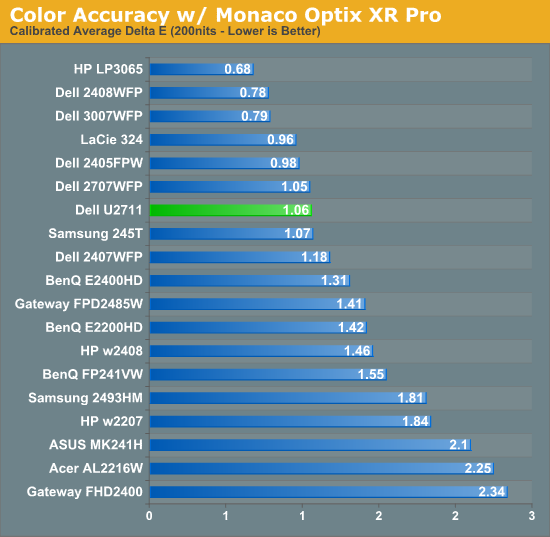
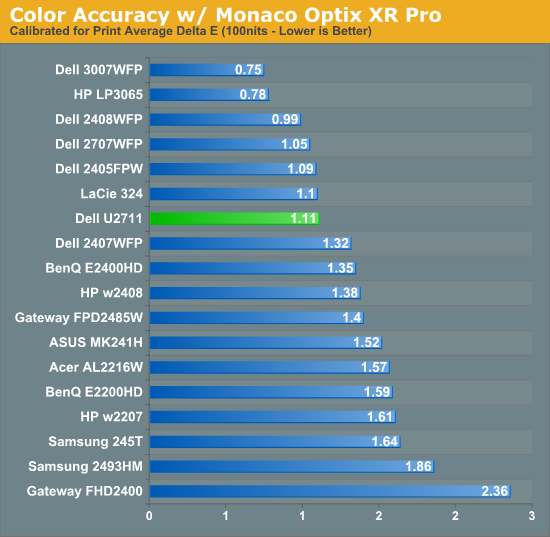
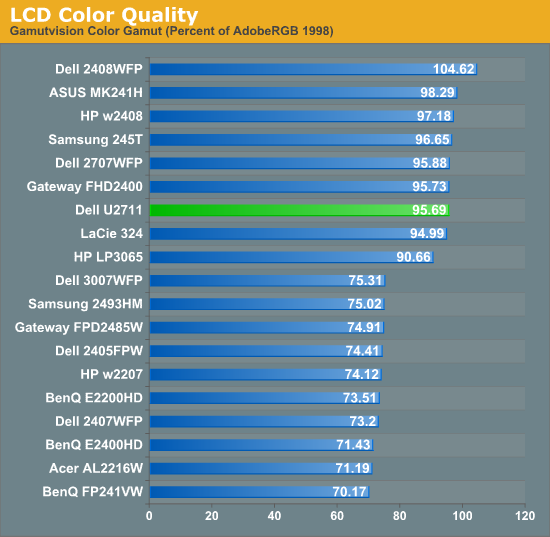
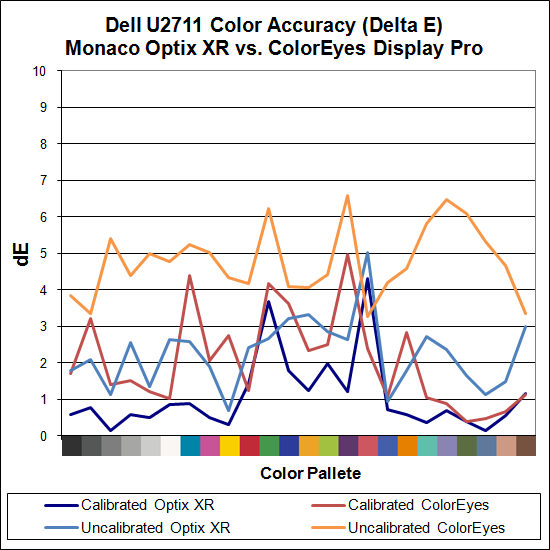
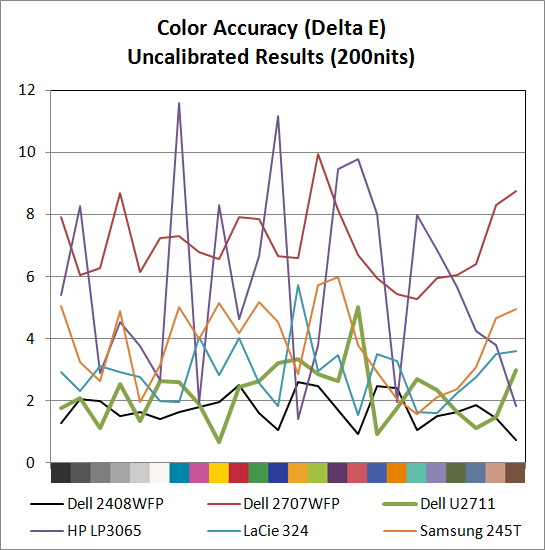
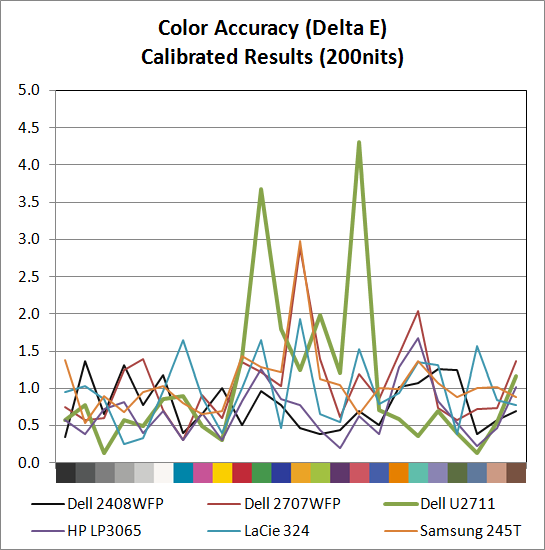
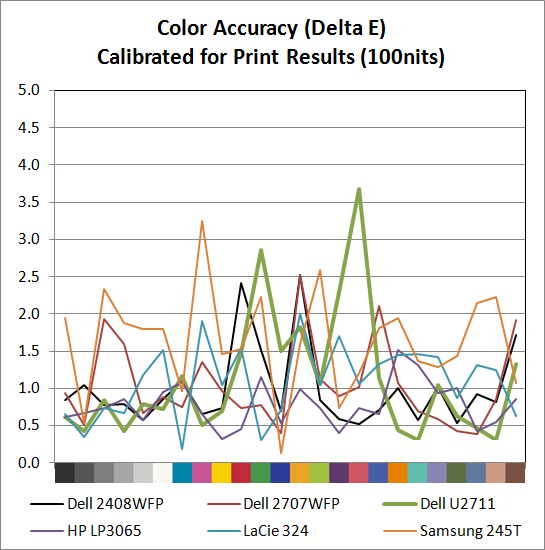
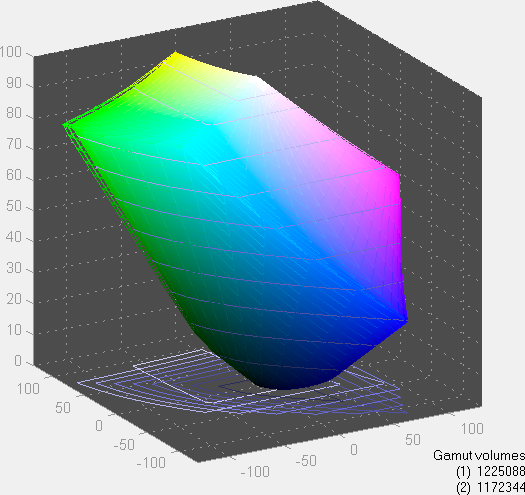
The U2711 scores extremely well in color gamut, and it achieves the 96% of Adobe RGB that Dell claims in their literature (not that most users would really notice the difference between any of the displays rated 90% to 105% - at least not after you eliminate the TN panels). Color accuracy on the other hand is a bit of a mixed bag. Dell ships a paper with test results showing the color calibration of each individual U2711, with the claim that the displays will have an average Delta E of less than 5.0 without any end-user calibration (when using the sRGB and Adobe RGB settings). Dell uses Minolta Color Analyzer CA210 and 32 test colors while we test with ColorEyes Display Pro and Monaco Optix XR Pro and 24 test colors, but our Monaco results confirm their claim. We're not sure why, but we continue to get better results using Optix XR Pro than with ColorEyes Display Pro.
As far as Optix is concerned, the U2711 achieves the rated Delta E of < 5.0 at just 2.24 without calibration, which is an excellent result. In fact the U2711 has no colors in the standard Gretag Macbeth 24 color palette score higher than 5.0 (and only reddish-pink scores a 5.0 measurement). The only LCD we've tested that did better is Dell's own 2408WFP (which also, interestingly enough, had an Adobe RGB color gamut of 105%). ColorEyes also gives an average Delta E of less than 5.0, but at 4.78 the score isn't nearly as remarkable, with nine color measurements well above 5.0. The uncalibrated (Monaco) results put the U2711 ahead of the HP LP3065, Dell 2707WFP, Samsung 245T, and LaCie 324 - and just about every other LCD we've tested.
Switch to the calibrated results and the U2711 doesn't impress quite as much relative to the competition. Monaco gives the U2711 an average Delta E of 1.06, which is great, but there are two results above 3.0 (the worst is reddish-pink again, this time at 4.31) compared to displays like the HP LP3065 where the highest measured Delta E is just 1.68. Dell's own 2707WFP, a three-year-old offering, also delivered a similar average Delta E but with only two colors above 2.0 (and still under 3.0). For a better LCD (i.e. not a TN panel), the results are really only slightly above average. It is possible different calibration software would achieve a better end result, but really we're talking about a "problem" that only the most demanding users are likely to ever notice.
Color Consistency
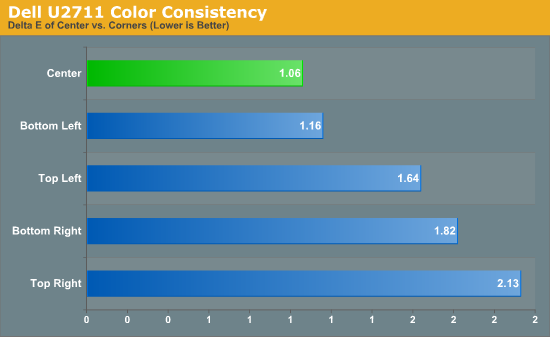
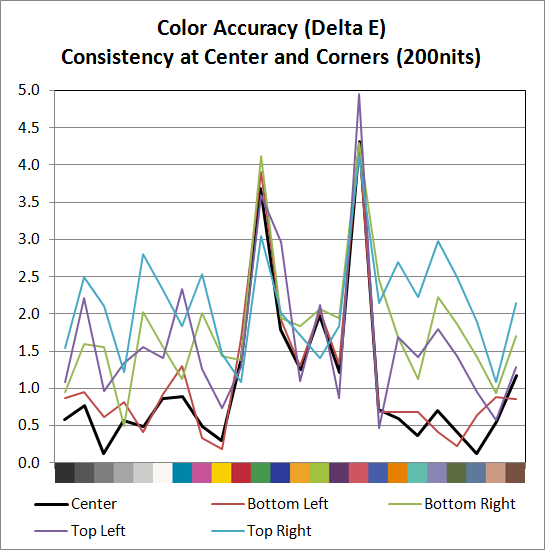
We added another test to try and measure the panel consistency across the entire surface. We measure Delta E at the center of the display, but what happens on the edges? To test this, we used the same profile generated in our best Delta E test result and measured Delta E again at the four corners. Most of the scores are similar, with a slight increase in average Delta E relative to the center measurement. The bottom-left corner is nearly identical to the center measurement, the top-left and bottom-right are a bit worse, and the top-right corner gets the overall worst result. While on the one hand we could say that the Delta E on the top-right is twice that of the center measurement, it's not a case of being "twice as bad". In fact, the color consistency is very good, and we didn't notice any "hot spots" are areas where the colors were clearly off relative to the rest of the LCD.










153 Comments
View All Comments
Mumrik - Saturday, January 23, 2010 - link
This seems very odd to me:"While we know some of you would like us to compare performance to a CRT, few users have CRTs these days and all we're really interested in measuring is the relative lag."
That is an incredibly weak argument for not getting proper numbers. I don't get it - why don't you care?
Anandtech would never only show the FPS scores of the 5870 as a percentage of a benchmark GPU, so why do this?
JarredWalton - Sunday, January 24, 2010 - link
1) I don't have a CRT.2) I have limited space.
3) I don't want to have a CRT - I ditched all of the ones I had about four years ago.
4) I would need a CRT that can support resolutions up to 2560x1600 -- none I'm aware of handle more than 2048x1536.
5) CRTs are terrible at getting correct geometry. Pincushion and trapezoidal distortion are all too common, even after lots of time spent fiddling to try to get it "just right"... and if you change resolution or refresh rate, you have to do it all over.
6) If CRTs are faster, add 20ms or 40ms or whatever to my numbers.
Lag between user and display comes from mouse, GPU, CPU, and LCD, really - up to around 200ms in some tests. You'll never eliminate all of it, and even CRTs have some "lag".
Besides, no one is making new CRTs that are worth buying, so why should we continue to compare to them? FWIW, my five year old CRT was getting dim when I got rid of it, so I couldn't even use it for comparison anyway. I'd need a new, high-quality CRT to make the comparison even remotely meaningful.
Mumrik - Sunday, January 24, 2010 - link
Its not really an argument about the merits of owning a CRT. It's about having a proper zero to benchmark against. I don't really see what most of those arguments have to do with measuring a lag time and "I don't have a CRT" is a very surprising reason to see on what I consider one of the nets premier hardware sites. Anandtech always seems to have all the esoteric equipment in the world to work with, both hardware AND testing equipment...This is not some sort of personal attack on you by the way.
Also, it looks like Sony's FW900 will do 2560x1600.
JarredWalton - Monday, January 25, 2010 - link
Here's an email I just sent to someone else on this subject (with a few edits):As far as input lag and the HP LP3065, if you trust another source you can find an LCD where we overlap, look at their result and look at my result, and then add the difference. But then, I'm not sure what other source I would trust, because I have seen sites report some of the LCDs I have as a "0" as anything from 0 to 20ms. None of them go into detail as to how they're testing (i.e. what stopwatch program they use, and how many pictures they take and average).
Anyway, here's one comparison to a CRT with the LP3065:
http://www.widescreengamingforum.com/forum/viewtop...">http://www.widescreengamingforum.com/forum/viewtop...
"I noticed no input lag at all with this thing. I took around 20 pics comparing input lag with a CRT -monitor and the worst lag I got was 24 ms, and the best was 0 ms."
So my choice of reference LCD has at most 24ms of lag compared to a CRT, and as little as 0ms, or perhaps an average of around ~12ms. But then, all CRTs aren't created equal, so what CRT do you use as a reference point?
I've seen other LCD vs. CRT tests where they post images of an 2405FPW and it gets an average of 35ms versus a CRT (http://www.hardforum.com/showthread.php?t=1047842&...">http://www.hardforum.com/showthread.php?t=1047842&..., which would mean the LP3065 is somewhere in the vicinity of 10ms average most likely.
Ultimately you're stuck trusting some source for your information about input lag. All I can tell you is that I've played a lot of games on the LP3065 and have never, ever noticed any form of lag. I've played games on a 2405FPW and barely noticed lag, and I've played games on the 2408WFP and definitely noticed lag. I could list a dozen more LCDs, and the fact is that not a single one has had less lag than the LP3065 in testing; they have only managed to tie it -- and many of the TN panels I've tested were recorded as "no lag versus CRT" at other sites.
If I ever find an LCD that has less lag than the HP LP3065, I'll make sure to mention it, but when I can confidently say that there's no current LCD that does better in that area, why beat a dead horse any more than we already have?
Every chart on the internet can be misleading if you don't know what you're looking at, which is why I explain in detail exactly what I'm doing. Plus, not all stopwatch programs are created equal; at best they are accurate to 17ms on an LCD, since it only updates the display 60 times per second. I tried one program and had results that were off by as much as 100ms, where I showed a difference of only 10 to 30ms with 3DMark03 as the time source.
So why not accept that the LP3065 is my zero point, and unless and until another LCD can beat it there's not much point in worrying about it. TN panels with "0ms lag" tie the LP3065, so it must therefore also have 0ms lag. If you trust my testing procedures, of course.
(And will I need to go over this AGAIN when I do another LCD review? A reference point is just that, and I can't find anyone that can give me a clearly better reference point. 10ms at most doesn't count....)
redbone75 - Saturday, January 23, 2010 - link
I don't even see how this can even be listed as a complaint, no matter how minor. To me, this ranks right up there with the classic complaining about the speakers on monitors. Should makers of ultra premium displays cater to people with less than stellar eyesight? Isn't the point of it all to be able to resolve finer and finer detail? It just sounds funny: "Man! This monitor is too sharp!"san1s - Saturday, January 23, 2010 - link
you are crazy, this is a valid complaint that should be noted in the reviewI'm glad that you have perfect vision- but many people, like me, don't. I would be angry spending my money on something only to find out later (since it wasn't noted) that I would have to change settings so becomes actually usable!
strikeback03 - Monday, January 25, 2010 - link
Well, resolution/pixel pitch is something each consumer should educate them on first. As it is a major point of this monitor, it probably isn't so much a complaint ("This is bad") as a caution ("This is something you have to know how to deal with")CSMR - Monday, January 25, 2010 - link
Yup, just "This is something you deal with by increasing the dpi setting" would be sufficient.Amazing that you get posters on AnandTech not understanding this. What will they say next? "Don't get that 1080p screen, your 720p movies will look small and your 480p dvd you can hardly see."
Voo - Saturday, January 23, 2010 - link
I disagree. Just because you have a stellar eyesight, doesn't mean the notice isn't justified, because this IS interesting for a lot of people.If it's so small that I have problems reading text that IS a problem for me and should be at least mentioned in the text. If it's not a problem for you, that's fine, you don't have to agree with the review in every point.
It just sounds funny: "I don't have a problem with it, so it's perfect for anybody!" Talk about empathy..
Voo - Saturday, January 23, 2010 - link
I disagree. Just because you have a stellar eyesight, doesn't mean the notice isn't justified, because this IS interesting for a lot of people.If it's so small that I have problems reading text that IS a problem for me and should be at least mentioned in the text. If it's not a problem for you, that's fine, you don't have to agree with the review in every point.
It just sounds funny: "I don't have a problem with it, so it's perfect for anybody!" Talk about empathy..